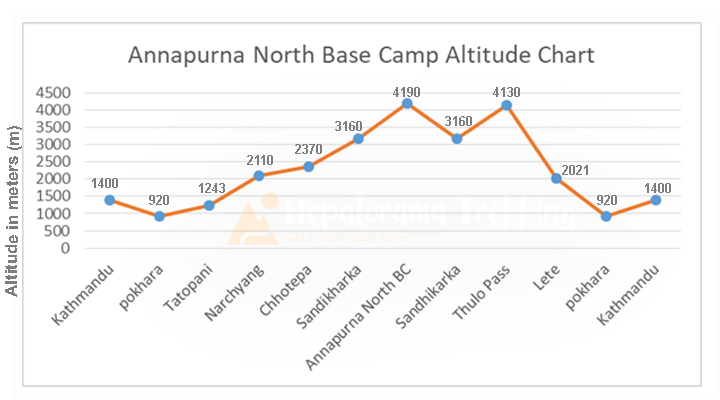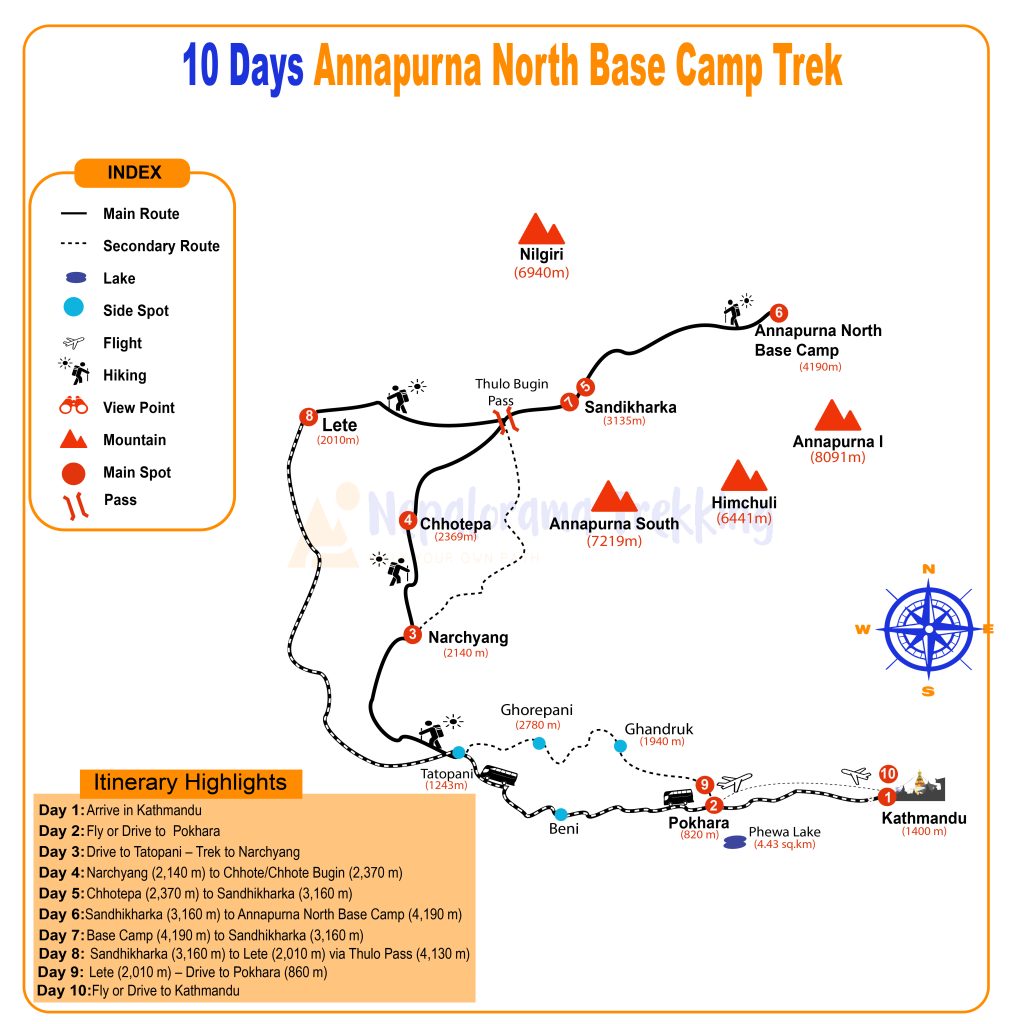Trip Fact
There are some important facts about the Annapurna North Base Camp Trek
-
Max Altitude 4,190m
-
Difficulty Moderate
-
Duration 10 Days
-
Trip Profile Annapurna North base Camp Trek, Annapurna Region
-
Type Trekking
-
Accommodation 4/5 Star hotel in Kathmandu and Teahouse during the trek
-
Meals All meals Include(B,L,D)
Detail Overview
Nepal’s Annapurna North Base Camp trek is a once-in-a-lifetime adventure trek in Nepal. This 10-day itinerary combines scenic flights, remote camping, and cultural villages for trekkers of all levels. Highlights include flying (or taking a bus) from Kathmandu to Pokhara, visiting Tatopani’s hot springs, and crossing the historic Maurice Herzog trail through Ghale villages like Ghasa and Lete. The trek offers panoramic views of Annapurna I, Machhapuchare (Fishtail), Dhaulagiri, Nilgiri, and more, plus waterfalls and high glacial lakes (e.g. scenic Pancha Kunda) along the way. This is a true adventure trek in Nepal: from dense rhododendron forests up to bare alpine deserts, with wildlife and rare herbs. Unlike popular teahouse treks, most nights above ~3,000 m are in tents (no lodges). The final days descend via the motorable road, returning through Pokhara to Kathmandu.
- Highlights: Flight between Kathmandu and Pokhara (25 min) vs 7–8 h bus; idyllic lakeside Pokhara; Gurung and Thakali villages (Tatopani, Narchyang, Ghasa, Lete); sunrise/sunset over Annapurna peaks; unique wildlife (snow leopard, musk deer); remote camping under the stars.
- Experience: Off-the-beaten-path trekking (Maurice Herzog Trail); cultural immersion with Magar/Thakali communities; rare sights like Pancha Kunda Lake and Futfutey Waterfall. Moderate daily distances (6–7 h) through varied terrain.
- Route Map: The Annapurna North Base Camp route map follows the classic Annapurna trail north of the Annapurna Conservation Area. Key waypoints are Tatopani – Narchyang – Chhotepa – Sandhikharka – Thulo Bugin – North Base Camp – Thulo Bugin (return) – Tatopani. (See detailed maps in trekking guides.)
Cost: Camping treks are pricier due to gear and guides. For example, a local 10-day package starts ~US$950–1475/pax. Simple camping-only tours can be ~$490/pax for 2 people.
Annapurna North Base Camp Trek Altitude profile

Annapurna North Base Camp Trek Detail Itinerary
For your Nepal tour, choose to follow this exact itinerary or ask us to customise your trip.
Arrive in Kathmandu
flight to Pokhara
Drive to Tatopani and Trek to Narchyang
Trek Narchyang to Chhote/Chhote Bugin
Trek Chhotepa to Sandhikharka
Trek Sandhikharka to Annapurna North Base Camp
Back to Sandhikharka
Sandhikharka to Lete via Thulo Pass
Drive to Pokhara
Fly or Drive to Kathmandu and Celebrate!
Goodbye Nepal
Annapurna North Base Camp Trek Route Map

What's Included
- Transfers from and to Kathmandu International Airport
- Tourist bus from Kathmandu to Pokhara and Pokhara to Kathmandu (optional for an extra cost: return domestic flights)
- Excellent 3* hotel shared accommodation (twin or triple share) in Pokhara and Kathmandu with breakfast (optional for an extra cost: choose to stay in a mid-range or luxury city hotel)
- Private ground transport to and from the trek
- Shared accommodation in teahouses (usually 2 people per room) during the trek
- All meals during the trek – choose a standard option from the menu at breakfast, lunch and dinner, each served with a cup of tea or coffee
- Experienced and friendly English-speaking Guide; their salary, accommodation, meals and insurance
- Porter (1 between 2 people, to carry a maximum of 12kg per trekker); their salary, accommodation, meals and insurance (optional for an extra cost: 1 porter per person, maximum 24kg load)
- Trekking permits
- Celebration meal in a great local restaurant (with a cup of tea or coffee)
- All government taxes
- Trek route map and completion certificate
- First aid medical kit with an oximeter.
- Fresh/dry fruits along the trek
What's not Included
- Meals not specified in the ‘INCLUDED’ costs above
- Additional tea, coffee, all mineral water (we recommend water purification tablets), and bar bills (coke, juice, beer, etc.)
- International airfare
- Travel insurance
- Nepal entry visa fees
- Tips for guides and porters
- Sightseeing costs (transport, attraction entry fees and cultural tour guide)
- Extra night accommodations due to changes in itinerary.
- Extra night accommodations due to changes in itinerary.
- Credit card fees and bank charges (no charge if cash paid in a major currency)
Annapurna North Base Camp Trek Gallery
Annapurna North Base Camp Trek FAQs
How difficult is the Annapurna North Base Camp trek, and can beginners do it with training?
The Annapurna North Base Camp trek is considered a moderate trek with a remote wilderness experience. You’ll be hiking for 5 to 7 hours daily over rugged terrain with gradual elevation gain. While there’s no technical climbing involved, the lack of established tea houses above ~3,000 meters, cold nighttime temperatures, and tent camping add to the physical challenge.
However, beginners who prepare with regular cardio, hill training, and strength exercises can complete this trek. Many first-time trekkers have successfully reached North Base Camp with a good guide, proper gear, and pacing.
What permits are required for the Annapurna North Base Camp trek, and where do I get them?
To legally trek to Annapurna North Base Camp, you need two permits:
Annapurna Conservation Area Permit (ACAP) – approximately USD 25
TIMS Card (Trekkers’ Information Management System) – approximately USD 15–20
You can obtain both permits from the Nepal Tourism Board office in Kathmandu or Pokhara. These fees contribute to trail maintenance, conservation efforts, and supporting local communities. Ensure your permits are in hand before departing Pokhara or Beni.
What kind of accommodation can I expect during the Annapurna North Base Camp trek? Are tea houses available?
Accommodation along the Annapurna North Base Camp route is extremely limited.
In lower villages like Narchyang or Lete, you might find basic guesthouses.
Beyond ~3,000 meters, there are no tea houses, and you’ll need to camp in tents.
This trek is more remote than the popular Annapurna Base Camp route. Therefore, trekkers typically carry group camping gear, including tents, sleeping bags, and cooking supplies. A local guide and porter service often handle logistics and equipment transport.
What gear should I bring for the Annapurna North Base Camp trek?
You’ll need both regular trekking gear and specialized equipment for high-altitude camping. Here’s a checklist:
Layered clothing system (thermal base layer, fleece jacket, down jacket, waterproof shell)
Warm sleeping bag (rated to at least –10°C)
Tent, sleeping mat, and camping stove (usually carried by your guide/porter)
Sturdy hiking boots, gloves, hat, and trekking poles
Water purification tablets, sunscreen, sunglasses, and a power bank
Snacks and personal medical kit, including altitude sickness tablets (e.g., Diamox)
Camping gear must be of good quality, as temperatures at night can fall below freezing.
Is altitude sickness a concern on this trek, and how can I prevent it?
Yes, altitude sickness is a concern since the highest overnight elevation is 4,190 meters at the North Base Camp.
To minimize your risk:
Ascend gradually, giving your body time to acclimatize
Drink plenty of water and avoid alcohol or smoking
Watch for symptoms: headache, dizziness, nausea, shortness of breath
Trekkers are advised to carry Diamox (consult your doctor) and descend immediately if symptoms worsen. Your guide may also carry oxygen or a portable altitude chamber for emergencies.
Is travel insurance necessary for the Annapurna North Base Camp trek?
Yes, comprehensive travel insurance is mandatory, especially since the trail is remote and lacks medical infrastructure.
Your insurance should cover:
High-altitude trekking (up to 5,000 meters)
Emergency helicopter evacuation
Medical expenses and trip cancellation
Some reputable insurance providers include World Nomads, IMG Global, and Global Rescue. Always read the fine print and keep a digital and printed copy of your policy.
When is the best time to trek to Annapurna North Base Camp?
The ideal seasons for the Annapurna North Base Camp Trek are:
Autumn (September to November): Clear skies, stable weather, panoramic mountain views
Spring (March to May): Mild temperatures, blooming rhododendrons, great visibility
Avoid the monsoon season (July to August) due to slippery trails and landslides. Winter (December to February) brings heavy snowfall and extremely cold temperatures, making camping difficult without advanced gear.
What is the route to Annapurna North Base Camp like? Is there a map or a marked trail?
The trek follows the historic Maurice Herzog Trail, named after the first climber to summit Annapurna I in 1950.
Key route highlights:
Start from Tatopani or Narchyang, continue through Ghasa, Lete, and climb to Thulo Bugin Pass
Reach the Annapurna North Base Camp (4,190 m)
There are no official signposts beyond Lete, so a knowledgeable guide is crucial for navigation. Offline GPS maps and apps like Gaia or Maps.me can be helpful, but not sufficient on their own.
What is the cost of the Annapurna North Base Camp trek for 10 days?
Trek cost depends on the level of service and group size:
Trek Style
Estimated Cost (PerPerson)
Fully Guided Camping Trek
USD 950 – 1,475
Budget Camping Trek (Group of 2+)
USD 490 – 700
Inclusions usually cover:
Permits (ACAP + TIMS)
Kathmandu–Pokhara transport (flight or bus)
Meals, camping equipment, guide & porter
Accommodation in Kathmandu and Pokhara
Exclusions: Personal gear, insurance, snacks, tips, and emergency evacuation (unless included in your insurance).
Should I hire a guide and porter for the Annapurna North Base Camp trek?
Yes. Hiring a local guide and porter is highly recommended for this route. The trail is remote, sparsely marked, and includes rugged wilderness areas where self-navigation can be risky.
A guide helps with:
Navigation
Altitude management
Communication with locals
Setting up camp and cooking
Porters help carry heavy equipment and lighten your load so you can trek comfortably.






